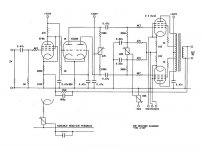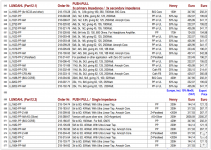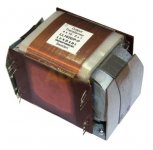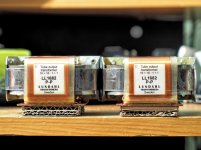I'm planning to build an EL34 PP amplifier, and I've been doing a lot of reading about Claus Byrith's '4-30' Mullard variant amp.
In Mr Byrith's excellent documentation, he recommends the Lundahl LL1663 PP output transformer, a 5k:8 ohm UL transformer
Links: Byrith Amplifier: http://www.asinus.dk/Asinus_Elektroakustik/Home_files/amplifier_30wpp.pdf
Schematic is on pg. 19
Lundahl LL1663 Output Transformer https://www.lundahltransformers.com/wp-content/uploads/datasheets/1663.pdf
However, I noticed on the Lundahl page about the Byrith design, there is the following statement:
The LL1682/PP is listed as a 5.5k:5 ohm transformer. https://www.lundahltransformers.com/wp-content/uploads/datasheets/1682.pdf
Here's the beginner question:
I know that speaker impedance varies a lot with frequency, but won't a 'nominal 8 ohm speaker' reflect 8.8k back to the primary of a 5.5k:5ohm transformer?
If so, isn't that quite a bit different than the designer's specification of a 5k primary?
Will using the LL1682 require some modification of the circuit?
In Mr Byrith's excellent documentation, he recommends the Lundahl LL1663 PP output transformer, a 5k:8 ohm UL transformer
Links: Byrith Amplifier: http://www.asinus.dk/Asinus_Elektroakustik/Home_files/amplifier_30wpp.pdf
Schematic is on pg. 19
Lundahl LL1663 Output Transformer https://www.lundahltransformers.com/wp-content/uploads/datasheets/1663.pdf
However, I noticed on the Lundahl page about the Byrith design, there is the following statement:
(Also the Output transformer LL1682/PP works very well in this design)
The LL1682/PP is listed as a 5.5k:5 ohm transformer. https://www.lundahltransformers.com/wp-content/uploads/datasheets/1682.pdf
Here's the beginner question:
I know that speaker impedance varies a lot with frequency, but won't a 'nominal 8 ohm speaker' reflect 8.8k back to the primary of a 5.5k:5ohm transformer?
If so, isn't that quite a bit different than the designer's specification of a 5k primary?
Will using the LL1682 require some modification of the circuit?
Attachments
The short answer is:

PS.: Lundahl makes good tranformers, but I don't understand why they can't figure out a way to split the secondaries to offer both 4 and 8 ohms loads.
- If your speakers are nominally 8 ohms, use the 1663
- If your speakers are nominally 4 ohms, use the 1682
- Power output is above 30W from 4.5K to 9.5K
- THD is below 1% from 5.5K to 9.5K
PS.: Lundahl makes good tranformers, but I don't understand why they can't figure out a way to split the secondaries to offer both 4 and 8 ohms loads.
Last edited:
....won't a 'nominal 8 ohm speaker' reflect 8.8k back to the primary of a 5.5k:5ohm transformer? If so, isn't that quite a bit different than the designer's specification of a 5k primary?....
At the same THD you may get 25 Watts instead of 30 Watts. In Hi-Fi this is not a real problem. You either have "ample" power or you want MUCH more power.
The general effect of a higher load is lower power and perhaps lower THD. In triodes the effect is small. In sharp pentodes (6L6) you can bench-test right on the knee of the plate curves and test power falls off as load changes. In loudspeaker work our load is never exact and the effects are not-large. UltraLinear mode will be in between.
The _EL34 datasheet page 3_ shows a w-i-d-e range of possible load impedances, from 2.8k to 11k.
If you digest these numbers, there is a trend. Increase the B+, you must reduce the current to keep the heat reasonable. Then with this new V/I ratio you must increase the load impedance for best fit. In general, 2X the B+ leads to 1/2 the current and 4X the load.
On this trend, a change from 5k load to 8.8k load is 1.76X Z and suggests 1.32X voltage, 0.75X current will get you back to "optimum". It also wants 1.32X the grid drive, so higher supply to the driver, but this comes naturally when you pick the main B+ higher.
So you could re-design the power pack from 450V to 580V, and set idle current to 30mA (300mV), and get very near the "same" 30 Watts at low THD with 8.8k load.
While this will change testbench results, I don't think it will play music any different.
...I don't understand why they can't figure out a way to split the secondaries to offer both 4 and 8 ohms loads.
It would be "a compromise". Ideally we want the lowest possible winding resistance, and we want all the primary flux to intercept all the secondary turns.
Transformer design starts by picking a core, and thus a winding window size. You allocate half that window to primary, half to secondary.... they are equally important. (At hundreds of Volts, the primary needs a little more space for insulation, maybe 60:40 allocation.)
An ideal goal is to support 4/8/16 taps. If you use a single tapped winding all the same gauge, the 4 winding is half the total. Half your secondary space is un-used when working on the 4 tap. DCR is double what it could be. You can use multiple gages and get the disadvantage down to 1.4, but that is still annoying to the transformer designer. You can bring out a lot of leads and make the user series-parallel to make 4 8 or 16. Hammond did that, and eventually gave up, too confusing. The original Williamson went whole-hog and gave you about 8(?) small windings you connected many ways to get a best-fit for 4/8/16.
Also, especially above 5K load and very wideband audio, you want all the primary flux to intercept all the secondary turns. The Byrith paper page 26 shows the power response well down at 80KHz, typically due to leakage inductance in series with load. This means breaking the primary *and* secondary into multiple layers/pies, interleaved so everything is intimate. Multiple secondary windings with multiple taps in several gauges is a real complication in winding.
If you look at "the whole audio system" with only so-much raw power available and often a choice of speakers not all the same nominal impedance, then multi-tap is valuable. But looking only at the rather complex problems of transformer design, single output is "better".
FWIW: the problems of low-ratio autotransformers are very different than high-ratio transformers. Another solution (sometimes seen in old Theater systems) is a single impedance amplifier transformer plus an autotransformer to the impedance in use. But this roughly doubles cost and weight. And would baffle most users.
actually the lundahl way is technically better than secondary taps.PS.: Lundahl makes good tranformers, but I don't understand why they can't figure out a way to split the secondaries to offer both 4 and 8 ohms loads.
all magnetic flux is used, tighter coupling prim-><-sec ..
they make single output, OR multi out ( you serio-paralell ALL windings to get the needed impedance.)
http://www.lundahl.se/wp-content/uploads/datasheets/1679.pdf
http://www.lundahl.se/wp-content/uploads/datasheets/1620_3_7_9202.pdf
http://jacmusic.com/html/order/jacmusic-pricelist.pdf
Attachments
You've got a point re. the "Lundahl way".
That being said, and IIRC, DTN Williamson published, some 3/4 of a century ago, ways to split the secondary into chunks to be wired in serie/parallel to cover a range of loads while utilizing all of the copper.
So the Lundahl-do is NOT the only right way: the "other" way cost only a few bucks more in production for the extra sections.
That being said, and IIRC, DTN Williamson published, some 3/4 of a century ago, ways to split the secondary into chunks to be wired in serie/parallel to cover a range of loads while utilizing all of the copper.
So the Lundahl-do is NOT the only right way: the "other" way cost only a few bucks more in production for the extra sections.
There are many famous transformers which do have split secondaries and they're above Lundahl when it comes to sound quality. But Lundahl has made its decision, once the trannie is configured by wiring, no other choice of output impedance is possible.
So if you wire it for 8 Ohms output, never use a speaker with less impedance than 8 Ohms.
So if you wire it for 8 Ohms output, never use a speaker with less impedance than 8 Ohms.
Thanks for all that input; I appreciate it.
I apologize for not responding sooner, but I wasn't getting notifications of posts by email.
The only US/Canadian dealer I found for Lundahl (K&K Audio) is awaiting stock on the transformers, so I have some time to decide!
Are there other Lundahl dealers that would be better for me in Canada?
I apologize for not responding sooner, but I wasn't getting notifications of posts by email.
The only US/Canadian dealer I found for Lundahl (K&K Audio) is awaiting stock on the transformers, so I have some time to decide!
Are there other Lundahl dealers that would be better for me in Canada?
The 1682 PP is what Kevin...
Recommends for replacement on a ST70. He has nice looking covers that hold them in an upright configuration. I've got a pair to be used in a Mk III/MkIV clone. The only gripes are that the board where the leads come through could be marked, and where they exit straight out of the board puts them rather close to the housing. You might want to watch this and bend them after soldering your leads to the binding post. If you have any questions on this, don't hesitate to give Kevin a call. I did because of this same question and he was very helpful. Pic is of the ST70...not mine.
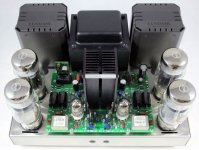
Recommends for replacement on a ST70. He has nice looking covers that hold them in an upright configuration. I've got a pair to be used in a Mk III/MkIV clone. The only gripes are that the board where the leads come through could be marked, and where they exit straight out of the board puts them rather close to the housing. You might want to watch this and bend them after soldering your leads to the binding post. If you have any questions on this, don't hesitate to give Kevin a call. I did because of this same question and he was very helpful. Pic is of the ST70...not mine.

I’m running the dynakitparts ST-70 with the K&K Audio driver board (version 1) with the stock transformers and think the sound quality is excellent. I bet with Lundahl Transformers it sounds even better. In fact, I was so happy with my ST-70 I’ve been slowly collecting parts for a build using the K&K Audio push pull power amp modules and amorphous Lundahl Transformers.
I'd been assuming that the Lundahl transformers were similar to other audio transformers (Hammond, Edcor,James,Transcendar, etc) and would be suitable for mounting on top of a chassis.
However, after reading the comments about the exposed connections and covers above, I looked for a picture of a Lundahl OT.
Really, they are completely unacceptable for exposed mounting without the very expensive ($60 US PLUS shipping, each) covers! This additional cost (more than $200 CAD for a pair) starts to put them out of my budget.
However, after reading the comments about the exposed connections and covers above, I looked for a picture of a Lundahl OT.
Really, they are completely unacceptable for exposed mounting without the very expensive ($60 US PLUS shipping, each) covers! This additional cost (more than $200 CAD for a pair) starts to put them out of my budget.
Attachments
Shop smart: I use these and they look OK. There are plenty more in this world.
Thanks, Zung.
Those prices are a bit more reasonable, for sure.
The exposed pins are problematic for sure and require special attention when getting shipped (ask me how I know). Lundahl are definitely not great transformers for an economic build. But the efficiency benefits of C-core vs E-I core are hard to deny.
A good workaround is to use an active subwoofer or two crossed over at 80hz. You would no longer need a massive transformer and could purchase custom iron from a more competitive company such as Edcor. A smaller, economic transformer (generally speaking) will have less low-frequency performance and lower self-capacitance and phase shift than a larger transformer wound the same way. Lower self-capacitance helps extend the high-frequency bandwidth. With an active subwoofer, you would have just as good bass extension (if not better) as you would with some of the more highly regarded brands.
A good workaround is to use an active subwoofer or two crossed over at 80hz. You would no longer need a massive transformer and could purchase custom iron from a more competitive company such as Edcor. A smaller, economic transformer (generally speaking) will have less low-frequency performance and lower self-capacitance and phase shift than a larger transformer wound the same way. Lower self-capacitance helps extend the high-frequency bandwidth. With an active subwoofer, you would have just as good bass extension (if not better) as you would with some of the more highly regarded brands.
I had a little trouble with the price myself...but started reminding myself that I wanted to build "the only amps I would ever need"...and then I scrimped and did some creative financing for a bit. Each one will go behind a pair of KT88's with one half of Roy Mottram's ST70 octal driver circuit out front. Almost ready to start the build on these monoblocs.
The tubesforhifi ST-70 board was what I was using before the K&K audio one. It’s really good. I keep feeling tempted to revert back to the tubesforhifi board because it feels a bit more “true” to the ST-70 whereas the K&K Audio board really calls for nicer transformers than is stock with the ST-70. I’m sure your build is going to be excellent. Keep us updated!
Thanks...I just like the simplicity of Roy's circuit and it looked easy to split the first stage into two 6J5's. So that's the plan...although it's taking some time to gather all the parts. Definitely spending more than I initially intended. Having a second interest is NOT conducive to getting even the first copy done...but will post when it happens.
"the only amps I would ever need"...
OH, NO!!
Then I will have to find a new hobby!!
Seriously, thanks for your input.

I haven't made the chassis/enclosure, so perhaps choosing one with enough depth to mount the transformers underneath is something I should consider.
Brinkman-
Thanks for the idea about subwoofer use - I'm trying to keep things simpler these days. I had a bi-amp setup with electronic digital crossover, and also a setup with subwoofer for a while, but now I have some pretty good speakers so I'm trying to restrain my impulse to get complicated again!
Thanks for the idea about subwoofer use - I'm trying to keep things simpler these days. I had a bi-amp setup with electronic digital crossover, and also a setup with subwoofer for a while, but now I have some pretty good speakers so I'm trying to restrain my impulse to get complicated again!
- Status
- This old topic is closed. If you want to reopen this topic, contact a moderator using the "Report Post" button.
- Home
- Amplifiers
- Tubes / Valves
- Which Lundahl OT for Byrith EL34 PP?
